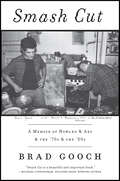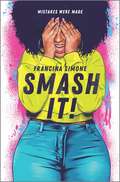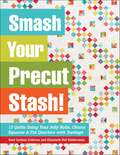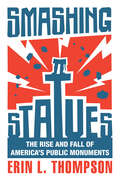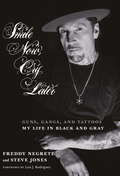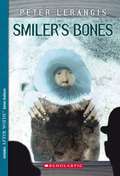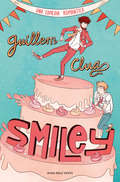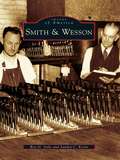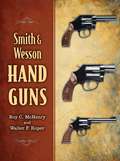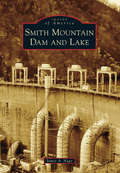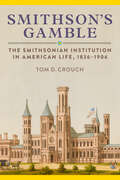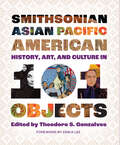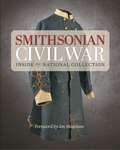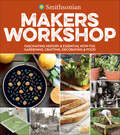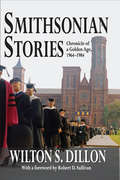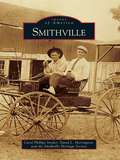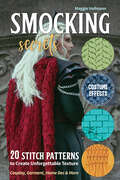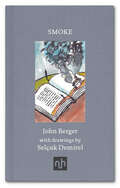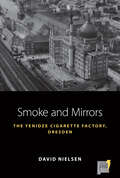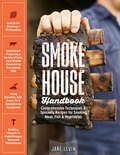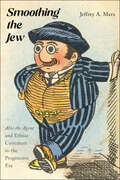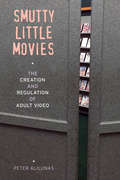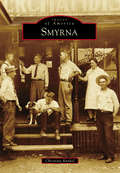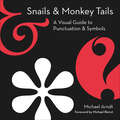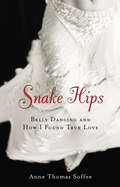- Table View
- List View
Smash Cut: A Memoir of Howard & Art & the '70s & the '80s
by Brad GoochThe author of the acclaimed City Poet returns with a searing memoir of life in 1980s New York City—a colorful and atmospheric tale of wild bohemians, glamorous celebrity, and complicated passions—with cameo appearances by Madonna, Robert Mapplethorpe, William Burroughs, and a host of others legendary artists.Brad Gooch arrived in New York in the late 1970s, yearning for artistic and personal freedom. Smash Cut is his bold and intimate memoir of this exhilarating time and place. At its center is his love affair with film director Howard Brookner, pieced together from fragments of memory and fueled by a panoply of emotions, from blazing ecstasy to bleakest despair.As both men try to reconcile love and fidelity with the irresistible desire to enjoy the freedom of the age, they live together and apart. Gooch works briefly as a model in Milan, then returns to the city and discovers his vocation as an artist. Brookner falls ill with a mysterious virus that soon has a terrifying name: AIDS. And the story, and life in the city, is suddenly overshadowed by this new demon plague that will ravage a generation and transform the creative world. Gooch charts the progress of Brookner through his illness, and writes unforgettably about endings: of a great talent, a passionate love affair, and an incandescent era.Beautifully written, full of rich detail and poignant reflection, recalling a time and a place and group of friends with affection and clarity, Smash Cut is an extraordinary memoir and an exquisite account of an epoch.Illustrated with 30 black-and-white photographs.
Smash It!
by Francina SimoneRefreshingly authentic and bold… Don’t miss this smashing #ownvoices novel from Francina Simone, filled with heart, humor and a heroine to root for!Olivia “Liv” James is done with letting her insecurities get the best of her. So she does what any self-respecting hot mess of a girl who wants to SMASH junior year does…After Liv shows up to a Halloween party in khaki shorts—why, God, why?—she decides to set aside her wack AF ways. She makes a list—a F*ck-It list.1. Be bold—do the thing that scares me. 2. Learn to take a compliment.3. Stand out instead of back.She kicks it off by trying out for the school musical, saying yes to a date and making new friends. Life is great when you stop punking yourself! However, with change comes a lot of missteps, and being bold means following her heart. So what happens when Liv’s heart is interested in three different guys—and two of them are her best friends? What is she supposed to do when she gets dumped by a guy she’s not even dating? How does one Smash It! after the humiliation of being friend-zoned? In Liv’s own words, “F*ck it. What’s the worst that can happen?” A lot, apparently.#SMASHIT
Smash Your Precut Stash!: 13 Quilts Using Your Jelly Rolls, Charm Squares & Fat Quarters with Yardage
by Kate Carlson Colleran Elizabeth Veit BalderramaNever let your favorite precuts go to waste again Have you ever bought the perfect stack of fat quarters, only to see that same bundle decorating your shelf two years later? Give stashed fabrics new life with 13 quilt patterns to make the most of your precut collection! Kate Carlson Colleran and Elizabeth Veit Balderrama, both of Seams Like a Dream Quilt Designs, show you the basics of how to quilt from your stash, with a special focus on color, print, and scale. More than a dozen vibrant and versatile quilt patterns are tailored to precut fabric strips, squares, and fat quarters. Learn how to add additional yardage, mix and match different fabric lines, and design a stunning quilt from fabric you already have on hand. 13 fresh patterns to use your stash of precut squares, strips, and fat quarters Options galore! Alternate colorways and precut choices, such as using 3 fat quarters, 11 precut strips, or 42 charm squares Tips for resizing quilts with multiple borders or border blocks
Smashing Statues: The Rise and Fall of America's Public Monuments
by Erin L. ThompsonA leading expert on the past, present, and future of public monuments in America. An urgent and fractious national debate over public monuments has erupted in America. Some people risk imprisonment to tear down long-ignored hunks of marble; others form armed patrols to defend them. Why do we care so much about statues? Which ones should stay up and which should come down? Who should make these decisions, and how? Erin L. Thompson, the country’s leading expert in the tangled aesthetic, legal, political, and social issues involved in such battles, brings much-needed clarity in Smashing Statues. She lays bare the turbulent history of American monuments and its abundant ironies, from the enslaved man who helped make the statue of Freedom that tops the United States Capitol, to the fervent Klansman fired from sculpting the world’s largest Confederate monument—who went on to carve Mount Rushmore. And she explores the surprising motivations behind contemporary flashpoints, including the toppling of a statue of Columbus at the Minnesota State Capitol, the question of who should be represented on the Women’s Rights Pioneers Monument in Central Park, and the decision by a museum of African American culture to display a Confederate monument removed from a public park. Written with great verve and informed by a keen sense of American history, Smashing Statues gives readers the context they need to consider the fundamental questions for rebuilding not only our public landscape but our nation as a whole: Whose voices must be heard, and whose pain must remain private?
Smile Now, Cry Later: Guns, Gangs, and Tattoos-My Life in Black and Gray
by Steve Jones Luis Rodriguez Freddy NegretePioneering black-and-gray tattoo artist Freddy Negrete was twelve years old and confined in the holding cell of a Los Angeles juvenile facility when an older teenager entered—covered in tattoos. Freddy was in awe, not just of the art, but of what it symbolized, and he wanted what this kid had: the potent sense of empowerment and belonging that came from joining a gang. The encounter drove Freddy to join the notorious gang La Sangra, and it didn't take long before he was a regular guest at LA County's juvenile detention facilities. By the age of twenty-one, Freddy had spent almost his whole life as a ward of the state in one form or the other.Enthralled by the black-and-gray tattoo style that in the 1970s was confined to the rebel culture of Chicano gangsters and criminals, Freddy started inking himself with hand-poked tattoos. Everyone wanted a piece of Freddy's black-and-gray style--gangbangers but also Hollywood starlets and film producers.In a riveting narrative that takes the reader from Freddy's days as a cholo gang member to evangelical preacher to Hollywood body art guru to addiction counselor, Smile Now, Cry Later is, ultimately, a testament to that spark within us all, that catalyst which gives us the strength to survive, transform, and transcend all that can destroy us.From the Hardcover edition.
Smiler's Bones
by Peter LerangisTrue story of Minik, an Eskimo boy who is seized from his tribe in 1897 Greenland by famed explorer Robert Peary, along with five other Eskimos, to be "presented" to the American Museum of Natural History.
Smiley
by Guillem CluaSmiley és una història d'amor en lletres majúscules. Una llegenda japonesa diu que quan dues persones estan destinades a estar juntes, un fil vermell invisible lligat al dit petit de la mà esquerra les uneix des del dia del seu naixement. Aquest fil no es pot trencar, i pot lligar-les per sempre, encara que siguin molt lluny l'una de l'altra i malgrat que puguin ser molt diferents. Aquest sembla el cas de l'Àlex i el Bruno, els protagonistes de la comèdia romàntica que ha emocionat milers d'espectadors arreu del món. Segurament no es fixarien mai l'un en l'altre, però un equívoc farà que el que ha començat com una cita qualsevol els acabi canviant la vida per sempre. Smiley és una història d'amor en lletres majúscules. Fa riure i emociona. Mostra les pors a les quals ens enfrontem quan ens enamorem i les contradiccions de les relacions afectives dins de la comunitat gai, marcades per l'influx de les noves tecnologies i les aplicacions de cites online. I, a la vegada, és una petita viquipèdia de l'ambient barceloní i un homenatge a les comèdies romàntiques de tota la vida, de Nora Ephron a Howard Hawks. Smiley és tot això i molt més, però per sobre de tot, és un cant a l'amor en totes les seves formes. Guillem Clua va estrenar Smiley, una història d'amor el 2012 a la diminuta Sala Flyhard de Barcelona. Interpretada per Ramon Pujol (Àlex) i Albert Triola (Bruno) i amb direcció de l'autor, l'obra va estar en cartell a diferents teatres de la ciutat i en gira per Catalunya gairebé tres anys. La benedicció del públic (d'allò més divers: parelles heterosexuals, grups d'àvies, famílies senceres...) va venir acompanyada de crítiques entusiastes i tota mena de reconeixements. Va fer temporada a Madrid i des d'aleshores ha voltat per tot el món en diverses produccions internacionals, de Santiago de Xile a Atenes, de Miami a Berlín, de Nàpols a Nova York. Les últimes ciutats on s'ha pogut veure són Brisbane (Austràlia) i Singapur. Smiley s'ha convertit així en un fenomen global, capaç de traslladar al mainstream una comèdia romàntica protagonitzada per dos homes, amb final feliç i petó de pel·lícula. Les relacions de parella, però, evolucionen. Algunes milloren i altres s'acaben... o es converteixen en tota una altra cosa. Què va ser de l'Àlex i el Bruno després d'aquell happy ending? Van aconseguir superar les seves diferències i formar una parella estable? Van ser monògams o van iniciar una relació oberta? Feliços o infeliços? Smiley, després de l'amor, estrenada a l'Aquitània Teatre el 2020, respon a totes aquestes preguntes i moltes més, perquè han canviat moltes coses des d'aquella primera cita del 2012. Barcelona ja no és la mateixa ciutat, i l'Àlex i el Bruno... tampoc: ara els preocupen la crisi dels quaranta, el matrimoni, el final de la joventut i la pèrdua de la innocència. Aquesta edició reuneix elstextos de Smiley, una història d'amor i Smiley, després de l'amor. I qui ho sap, potser l'any 2030 ens tornem a trobar amb l'Àlex i el Bruno amb una tercera part que molts espectadors i lectors ja esperen amb impaciència.
Smith & Wesson (Images of America)
by Roy G. Jinks Sandra C. KreinHorace Smith and Daniel Baird Wesson shared a dream of manufacturing a firearm that could fire repeatedly, using a new and self-contained cartridge. In 1852, the dream became a reality with the founding of Smith & Wesson Firearms Company. Over the next 154 years, the company grew to be one of the most innovative and respected firearms manufacturers in the world. The story of Smith & Wesson is not only about two knowledgeable and enterprising men but also the story of generations of creative and dedicated men and women. The spirit of innovation generated by the partners has long outlived them. Today Smith & Wesson is synonymous with quality, performance, and durability. Smith & Wesson explores the company history, its people, and significant products from the partners' first venture in 1852 to the sale of the Wesson family business in 1965. This book features rarely seen historical photographs, advertisements, and company documents culled from the company archives, museums collections, and the private collections of Smith & Wesson collectors.
Smith & Wesson Hand Guns
by Roy C. McHenry Walter F. Roper“The story of Smith & Wesson handguns and their evolution is one of the hallowed tales of American firearms’ history,” according to the firearms writer Jim Casada. Anyone who collects Smith & Wessons or is simply interested in their backstory will cherish this book.Though originally published in 1945, more than half a century ago, Smith & Wesson Hand Guns remains the source for Smith & Wesson enthusiasts. It is an authoritative reference and has remained, for over five decades, the cornerstone upon which Smith & Wesson research rests. This work is foundational, supported by sixty-three detailed illustrations showing the handguns, the unique hammer mechanism, and facsimile reproductions of vintage advertising copy.The first twenty-four chapters of the book, which tell the story of Smith and Wesson and the development of Smith & Wesson handguns, are very informative. After the reader becomes familiar with Smith and Wesson’s history together, as well as their creation of a business, illustrations exhibiting Smith & Wesson handguns will show rather than tell of their magnificence. Finally, descriptions of different caliber guns are given, where readers will gain invaluable information regarding Smith & Wesson handguns. For any Smith & Wesson enthusiast or collector, this work is impossible to put down.
Smith Mountain Dam and Lake (Images of America)
by James A. NagyThe construction of a dam in the gap of Smith Mountain in Pittsylvania County, Virginia, had been considered as early as the 1920s. However, the dam's construction did not begin until 1960. Smith Mountain Dam closed the gap completely in 1963, and Smith Mountain Lake began to fill and form behind it. The hydroelectric dam consists of 175,000 cubic yards of concrete and has the capacity to generate 605 megawatts of electricity for up to 11 hours. Smith Mountain Dam is part of a two-dam system on the Roanoke River, and its companion dam, the Leesville Dam, is a smaller structure designed to pump water back to Smith Mountain Lake and to also generate hydroelectric power for American Electric Power (AEP) customers. Smith Mountain Lake covers 20,000 acres and has a 500-mile shoreline, which borders Franklin, Pittsylvania, and Bedford Counties. Over the years, development near and around Smith Mountain Lake has exploded, and this has presented both opportunities and challenges in regard to stewardship of the area's natural resources.
Smithson's Gamble: The Smithsonian Institution in American Life, 1836–1906
by Tom D. CrouchDiscover the incredible history of the Smithsonian as it grew to meet the needs of a nationFollow the fascinating growth and development of the world's largest museum and research complex during its first 60 years. The English chemist and mineralogist James Smithson never visited the United States, yet he bequeathed his estate to the country to establish the Smithsonian Institution. The rest is history, told in rich detail in Smithson's Gamble. This book reveals how, as it defined a role rooted in curiosity and exploration, the Smithsonian helped to shape the nation's developing identity.The Smithsonian evolved from a small, narrowly focused organization into an institution leading the way in fields from astrophysics to zoology. Smithsonian researchers, and the hundreds of citizen scientists who they recruited, created a collection that documented the natural and human history of a continent. The American conservation movement and a national weather service are rooted at the Smithsonian. Smithson's Gamble is filled with fascinating characters, twists and turns, and moments of triumph and tragedy, complete with political machinations, a bit of backstabbing, accusations of murder, and the occasional scandal.Tom D. Crouch, a Smithsonian veteran of almost 45 years, paints a robust picture of a unique American establishment and its lasting legacies. He chronicles the trials and errors of an increasingly complex institution and all the incredible joys and innovations resulting from Smithson's gamble.
Smithsonian Asian Pacific American History, Art, and Culture in 101 Objects
by Erika Lee Lonnie G. Bunch III Theodore S. GonzalvesA rich and compelling introduction to the history of Asian Pacific American communities as told through 101 objects, from a fortune cookie baking mold to the debut Ms. Marvel comic featuring Kamala KhanSmithsonian Asian Pacific American History, Art, and Culture in 101 Objects invites readers to experience both well-known and untold stories through influential, controversial, and meaningful objects. Thematic chapters explore complex history and shared experiences: navigation, intersections, labor, innovation, belonging, tragedy, resistance and solidarity, community, service, memory, and joy. The book features vibrant full-color illustrations of objects that embody and engage with Asian Pacific American issues, including the immigrant experience, the importance of media representation, what history gets officially documented vs. what does not, and so much more. Those objects include: Name tag for Challenger astronaut Ellison OnizukaPhotograph of Hollywood actress Anna May WongHello Kitty bento boxStella Abrera's ballet shoes, pancaked to match her skin colorCaravan&’s Thailand: Songs for Life albumSewing kit of internment camp survivor May IshimotoNam June Paik's Electronic Superhighway: Continental U.S., Alaska, HawaiiThe Devanagari typographical font patented by Hari Govind GovilAsian Americans are the fastest growing group in the United States and include approximately 50 distinct ethnic groups, but their stories and experiences have often been sidelined or stereotyped. This spirited and beautifully illustrated book offers a vital window into the triumphs and tragedies, strength and ingenuity, and traditions and cultural identities of these communities. Smithsonian Asian Pacific American History, Art, and Culture in 101 Objects is a crucial and celebratory read.
Smithsonian Civil War: Inside the National Collection
by Jon Meacham Michelle Delaney Smithsonian Institution Hugh Talman Neil KaganSmithsonian Civil War is a lavishly illustrated coffee-table book featuring 150 entries in honor of the 150th anniversary of the Civil War. From among tens of thousands of Civil War objects in the Smithsonian's collections, curators handpicked 550 items and wrote a unique narrative that begins before the war through the Reconstruction period. The perfect gift book for fathers and history lovers, Smithsonian Civil War combines one-of-a-kind, famous, and previously unseen relics from the war in a truly unique narrative.Smithsonian Civil War takes the reader inside the great collection of Americana housed at twelve national museums and archives and brings historical gems to light. From the National Portrait Gallery come rare early photographs of Stonewall Jackson and Ulysses S. Grant; from the National Museum of American History, secret messages that remained hidden inside Lincoln's gold watch for nearly 150 years; from the National Air and Space Museum, futuristic Civil War-era aircraft designs. Thousands of items were evaluated before those of greatest value and significance were selected for inclusion here. Artfully arranged in 150 entries, they offer a unique, panoramic view of the Civil War.
Smithsonian Makers Workshop: Fascinating History & Essential How-Tos: Gardening, Crafting, Decorating & Food
by Smithsonian Institution50 DIY crafts, cooking, decorating, and gardening projects from the experts at the Smithsonian Institution The Smithsonian Institution presents a uniquely curated collection of lively how-to projects and historical narratives of four realms of American domestic arts: cooking, crafts, decorating, and gardening. Perfect for hobbyists interested in the historical context of what they create for their homes, this beautifully illustrated book contains fifty DIY projects—from a uniquely American quilt pattern to on-trend crafts like terrarium making and pickling—that all offer satisfying ways to bring history and culture to life. For those craving more, features provide rare insights from Smithsonian experts on prominent figures, events, and trends. Readers can learn about influential Americans who've had an impact on each realm; look at visual timelines of significant events that pushed development forward; or stay in the present and see how American arts in contemporary life is being redefined, all while enjoying satisfying and unique projects.
Smithsonian Stories: Chronicle of a Golden Age, 1964-1984
by Wilton S. DillonWhy is the Smithsonian more than the "Nation's Attic?" Or more than a museum complex? As Wilton S. Dillon shows, the Smithsonian came to be the institution we know today under the twenty-year leadership of "Sun King" S. Dillon Ripley.Ripley aspired to reinvent the Smithsonian as a great university�with museums. Although little understood by the public at large, it began as a basic research center. The Smithsonian remains a key contributor to the world of higher learning and functions diplomatically as the ministry of culture for the United States. Dillon provides backstage insights into Ripley's quest for the wholeness of knowledge. He describes how he inspired its role as a "theater of ideas as well as artifacts." Under his tutelage, the National Mall became a playground for world intelligentsia, an "intellectual free trade zone" in the shadow of the nation's political capital.Dillon reminds us that interdisciplinary, international Smithsonian symposia foreshadowed twenty-first-century issues and trends. His descriptions of the educational rewards of balancing tradition with the avant-garde are inspiring. As Dillon reminds us, Ripley's twenty-year reign may well have helped spark the waning embers of the Enlightenment.
Smithville (Images of America)
by Carol Phillips Snyder Smithville Heritage Society David L. HerringtonSmithville's reputation is that of a railroad town, yet it offers an even richer history. Fertile land and the Colorado River attracted pioneers with energy, dreams, and a hunger to build. After Thomas Gazley chose head-right land in Stephen F. Austin's Second Colony in 1827, area settlers joined the fray to secure a Texas free from Mexico's supremacy. Some represented Bastrop County in the new Republic of Texas's legislature. Others stayed home and built a village on the banks of the Colorado. Businessmen influenced the growth of Smithville by attracting the railroad, and soon Smithville was the largest city in the county, offering a place for businesses and families to thrive. Smithville's fortunes have risen and fallen with the railroad, the river, and the Central Texas economy, and it has again become a vital community, this time nurturing scientists, artists, filmmakers, and antique lovers.
Smocking Secrets: 20 Stitch Patterns to Create Unforgettable Texture
by Maggie HofmannSmocking made simple! 20 stitch patterns to create next-level cosplay Learn the art of smocking from award-winning costume designer Maggie Hofmann! With step-by-step instructions for 20 American and English smocking techniques, cosplayers can incorporate 3D textures, historical accents, and special effects like fish scales in their designs. Pre-smocked fabric is expensive, but now you can make your own stylish panels for every event. Smocking Secrets will give you the perfect jumping-off point to invent your own fancy flourishes! Take your costumes to the next level with the book’s companion product, smocking stencils in three gridded sizes. Add rich texture, 3D effects, and historical flair to your costumes with smocking Award-winning cosplayer Maggie Hofmann helps you achieve unique visual effects for theater-ready looks Pre-smocked fabric is expensive! Save money by making your own
Smoke
by John BergerA pictoral essay by the great art critic, novelist and long-time smoker, John Berger, and Turkish writer and illustrator Selçuk Demirel."Once upon a time, men, women and (secretly) children smoked."This charming illustrated work reflects on the cultural implications of smoking, and suggests, through a series of brilliantly inventive illustrations, that society's attitude to smoke is both paradoxical and intolerant. It portrays a world in which smokers, banished from public places, must encounter one another as outlaws. Meanwhile, car exhausts and factory chimneys continue to pollute the atmosphere. Smoke is a beautifully illustrated prose poem that lingers in the mind."A cigarette is a breathing space. It makes a parenthesis. The time of a cigarette is a parenthesis, and if it is shared you are both in that parenthesis. It's like a proscenium arch for a dialogue." - John Berger (in interview)
Smoke and Mirrors: The Yenidze Cigarette Factory, Dresden (Space and Place #22)
by David NielsenThe Yenidze Cigarette Factory of 1909 was constructed as an industrial, architectural object that advertised Dresden as a center for the tobacco trade. Born from a unique client-architect relationship between Hugo Zietz and Martin Hammitzsch, the factory’s importance to modernism has been understated. Smoke and Mirrors uncovers the history of the factory’s planning, design, and construction, and for the first time, apart from the building’s historical narrative, positions this addition to Dresden’s skyline within the formative histories of the modern movement.
Smokehouse Handbook: Comprehensive Techniques & Specialty Recipes for Smoking Meat, Fish & Vegetables
by Jake LevinFor backyard grilling enthusiasts, smoking has become an essential part of the repertoire. Butcher and charcuterie expert Jake Levin’s comprehensive guide, Smokehouse Handbook, guarantees mouthwatering results for producing everything from the perfect smoked salmon to a gorgeous smoked brisket. Levin demystifies the process of selecting the right combination of meat, temperature, and wood to achieve the ultimate flavor and texture. Detailed step-by-step photos show the various techniques, including cold smoking, hot smoking, and pit roasting. A survey of commercially available smokers critiques the features of each one, and for readers with a DIY bent, Levin includes plans and diagrams for building a multipurpose smokehouse. Featured recipes include specialty brines and rubs along with preparation guidelines for all the classic cuts of meat, including ham, brisket, ribs, bacon, and sausage, as well as fish and vegetables. With in-depth troubleshooting and safety guidelines, this is the one-stop reference for smoking success. This publication conforms to the EPUB Accessibility specification at WCAG 2.0 Level AA.
Smoothing the Jew: "Abie the Agent" and Ethnic Caricature in the Progressive Era
by Jeffrey A. MarxThe turn of the nineteenth century in the United States saw the substantial influx of immigrants and a corresponding increase in anti-immigration and nativist tendencies among longer-settled Americans. Jewish immigrants were often the object of such animosity, being at once the object of admiration and anxiety for their perceived economic and social successes. One result was their frequent depiction in derogatory caricatures on the stage and in print. Smoothing the Jew investigates how Jewish artists of the time attempted to “smooth over” these demeaning portrayals by focusing on the first Jewish comic strip published in English, Harry Hershfield’s Abie the Agent. Jeffrey Marx demonstrates how Hershfield created a Jewish protagonist who in part reassured nativists of the Jews’ ability to assimilate into American society while also encouraging immigrants and their children that, over time, they would be able to adopt American customs without losing their distinctly Jewish identity.
Smutty Little Movies: The Creation and Regulation of Adult Video
by Peter AlilunasIn the late 1970s, the adult film industry began the transition from celluloid to home video. Smutty Little Movies traces this change and examines the cultural and legal efforts to regulate, contain, limit, or eradicate pornography. Drawing on a wide variety of materials, Smutty Little Movies de-centers the film text in favor of industry histories and contexts. In so doing, the book argues that the struggles to contain and regulate pleasure represent a primary starting point for situating adult video's place in a larger history, not just of pornography, but of media history as a whole.
Smyrna (Images of America)
by Christina RunkelWith the Nashville & Chattanooga Railroad linking the two cities in 1850, more people began to build houses and claim land south of Nashville. The railroad added a way station in the community called Stewartsboro, which was incorporated in 1869 as Smyrna after the nearby Smyrna Presbyterian Church. The town's location along the railroad placed it in the path of both armies during the Civil War, and skirmishes were fought throughout the town. Confederate scout Sam Davis, honored for sacrificing his own life rather than betraying a friend, became a well-known figure. Smyrna residents primarily grew corn, wheat, and cotton until the mid-1900s, when industry began to outpace agriculture. In 1941, the Smyrna Army Airfield, known later as the Stewart Air Force Base, opened as a training facility for World War II soldiers. The early 1980s saw further industrial growth when Nissan of North America selected the town for a new manufacturing plant. Today, the town combines agriculture with industry as it continues to grow and prosper.
Snails & Monkey Tails: A Visual Guide to Punctuation & Symbols
by Michael Arndt"There are countless books that can teach you the alphabet, but almost none that focus on the tiny designs that run interference among the letterforms: those easily overlooked punctuation and typographic symbols. These symbols, as Michael Arndt proves in this beautiful and endlessly fascinating book, are absolutely indispensable to communication: punctuation turns words into sentences and language into meaning... From commas to semicolons, from slashes to asterisks, from guillemets to octothorpes (named, perhaps, after athlete Jim Thorpe), you’ll never look at punctuation the same way again."—Michael Bierut, partner, PentagramIn this show-stopping guide with more than 75 uniquely designed two-color spreads—a rollicking linguistic ride for fans of Eats, Shoots & Leaves and Just My Type—award-winning graphic designer Michael Arndt explores the typographic origins, names, and shapes of both common punctuation marks and symbols, as well as the proper and diverse usage of each.From the period to the question mark, the semicolon to the em dash, symbols and marks are an integral part of language. In graphically engaging spreads that utilize typography in an innovative way, Snails & Monkey Tails examines the evolution of these mighty linguistic tools—from the punctum, or point, created by an ancient scribe to the guillemet, used most commonly in lieu of quote marks by the French (and named in honor of a typographer Guillaume Le Bé). With verve and insight, Michael Arndt explains their proper usage and how they came to be universally accepted today. Snails & Monkey Tails—Snails (@); Monkey Tails (&)—is packed with intriguing facts, history, stories, and lore, as well as grammar, explaining it clearly and with examples. What is the purpose of the comma—perhaps the most used symbol in the English language—and what are the proper uses of the asterisk? Do quote marks go inside or outside punctuation? What about a quote within a quote—a quote from someone quoting someone else? How much space goes on either side of an ellipsis? What’s the difference between an en-dash and an em-dash? Complete with a listing of useful terms and clear diagrams for creating typographical marks and symbols correctly on both PC and Apple computers, Snails & Monkey Tails is essential for bibliophiles, writers, grammarians, graphic designers, typography enthusiasts, logophiles, and anyone with a passion for the written word.
Snake Hips: Belly Dancing and How I Found True Love
by Anne Thomas SoffeeThis hilariously uplifting memoir follows an Arab American woman's merry life as she shimmies her way from getting dumped by her tattoo-artist boyfriend to coming to grips with being single, ample, and 30. Feeling lost and heartbroken, Anne Thomas Soffee moves back home to Richmond, Virginia. Against the wishes of her extended family and friends, she enrolls in a belly dancing class hoping to heal her heart and reconnect with her Lebanese roots. Her life is never the same after she discovers the riotous world of American belly dancing, a warm and welcoming subculture where younger and thinner are not necessarily better. Wildly funny adventures ensue as a newly confident Soffee embarks on romantic adventures with a domineering sheik and a beautiful Lebanese boy-next-door. Among the zils (finger cymbals) and thrills of attending classes and performing in moose lodges and county fairs, Soffee is surprised to find happiness and true love along the way. This replaces 1556524587.
